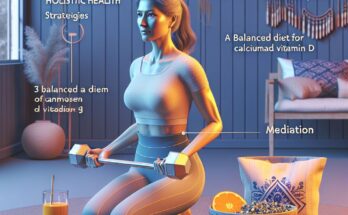When it comes to navigating the twists and turns of menopause, yoga can be your compass and anchor. This ancient practice is more than just stretching; it’s a holistic approach to wellness that can address the physical, emotional, and mental challenges that often accompany this stage of life. So, let’s dive in and discover how yoga can help you find inner balance and contribute to anti-aging during menopause.
Key Takeaways
- Yoga can significantly alleviate menopausal symptoms like hot flashes, joint pain, and mood swings.
- Regular practice of specific yoga poses can enhance flexibility, balance, and strength, which are crucial during menopause.
- Pranayama and meditation, integral parts of yoga, promote mental clarity and emotional resilience.
- Adapting a yoga routine to fit your daily life can provide ongoing support throughout menopause.
- Engaging in yoga may offer an alternative to hormonal therapy for managing menopausal symptoms.
Why Yoga is a Game-Changer for Menopausal Health
Menopause is a natural transition, but it can come with a host of uncomfortable symptoms. These can range from hot flashes and night sweats to mood fluctuations and sleep disturbances. Yoga, with its multifaceted approach, can be a powerful ally. By engaging in regular practice, you can not only soothe these symptoms but also improve your overall health and slow down the aging process.
The Link Between Yoga and Reduced Menopausal Symptoms
Yoga is like a balm for the body’s stress response system. During menopause, your body undergoes significant hormonal changes that can lead to increased stress and anxiety. By incorporating yoga into your life, you encourage your body to shift from the stress-induced ‘fight or flight’ mode to a more relaxed ‘rest and digest’ state. This shift is key to reducing menopausal symptoms.
- Yoga can lower cortisol levels, which are often elevated during stress.
- It increases the release of GABA, a neurotransmitter that promotes relaxation.
- Through mindful movement and breathwork, yoga helps regulate the nervous system.
Therefore, by reducing stress, yoga not only helps manage menopausal symptoms but also contributes to a more balanced and harmonious life.
From Flexibility to Mental Clarity: The Spectrum of Yoga’s Benefits
One of the most beautiful aspects of yoga is its ability to cater to a wide range of needs. For menopausal women, the benefits are particularly relevant. Regular yoga practice can lead to increased flexibility, which helps prevent the stiffness and aches that can come with aging. But the benefits don’t stop there.
Yoga also helps to build strength. Strong muscles support and protect your joints, which is vital as you age and especially during menopause when bones can become more fragile. And most importantly, yoga fosters mental clarity. As you focus on your breath and movement, you give your mind a break from the chaos of daily life. This mental break is crucial for managing the emotional rollercoaster that can accompany menopause.
For example, consider the story of Maria, a 52-year-old who started practicing yoga during her early stages of menopause. She found that not only did her hot flashes become less frequent, but her sleep improved and her mood swings stabilized. Maria’s experience is a testament to the holistic benefits of yoga for menopausal women.
Now, let’s explore some specific yoga poses that can offer relief from menopausal symptoms. These poses are not just about physical relief; they also help to cultivate an inner sense of calm and resilience.
Yoga Poses for Menopause Symptom Relief
Poses to Cool Down Hot Flashes
Hot flashes are one of the most common and uncomfortable symptoms of menopause. Certain yoga poses can help you cool down and feel more comfortable. For example, forward bends and seated poses that promote relaxation can be particularly beneficial.
- Child’s Pose (Balasana) encourages a sense of calm and can help regulate body temperature.
- Seated Forward Bend (Paschimottanasana) cools the body and calms the mind, which can reduce the frequency of hot flashes.
Stretches to Ease Joint Pain and Improve Mobility
Joint pain and stiffness are also frequent complaints during menopause. Yoga can help lubricate joints and maintain mobility.
- The Cat-Cow Stretch (Marjaryasana-Bitilasana) is excellent for spinal flexibility and can relieve tension in the back and neck.
- Gentle twists, like the Seated Spinal Twist (Ardha Matsyendrasana), can help maintain spinal health and ease discomfort in the back.
Flow Sequences for Energy and Vitality
Yoga sequences that link breath with movement, known as flow sequences, can be particularly energizing. These sequences, like the Sun Salutation (Surya Namaskar), can invigorate the body and mind, boosting energy levels which often dip during menopause.
Building Emotional Resilience with Yoga
Pranayama: Breathing Practices for Balance and Harmony
Breathing exercises, or Pranayama, are a cornerstone of yoga that can be particularly powerful for emotional balance during menopause. The practice of Pranayama helps to regulate the breath, which in turn can regulate the emotions.
- Nadi Shodhana, or Alternate Nostril Breathing, can bring a sense of balance and calm to the mind.
- Brahmari, or Bee Breath, is known for its ability to relieve frustration and anxiety.
Meditation and Mindfulness Techniques
Meditation and mindfulness can be incredibly supportive during menopause. By focusing on the present moment, you can reduce stress and improve your emotional well-being.
- Guided meditations can be a gentle introduction to the practice, especially if you’re new to it.
- Mindfulness practices, such as body scans or mindful walking, can be integrated into your daily life for ongoing stress management.
Customizing Your Yoga Practice for Menopause
Adapting Yoga to Your Daily Routine
Integrating yoga into your daily life doesn’t have to be a huge commitment. Even a few minutes a day can make a significant difference. The key is consistency. Try to establish a routine that fits into your schedule, whether it’s a full session or just a few poses to start and end your day.
Creating a Supportive Yoga Space at Home
Having a dedicated space for yoga at home can enhance your practice. It doesn’t have to be elaborate—a quiet corner with a mat and perhaps a few props like blocks or a bolster is enough. This space can become a sanctuary for you to connect with yourself and manage menopausal symptoms with grace.
Frequently Asked Questions (FAQ)
What Type of Yoga is Best for Menopausal Women?
Restorative and Yin yoga are often recommended for menopausal women because they are gentle and focus on relaxation. However, the best type of yoga is one that you enjoy and will practice consistently.
How Often Should I Practice Yoga During Menopause?
Aiming for at least 3 times a week is a good start, but even daily gentle practices can be beneficial. Listen to your body and adjust accordingly.
Can Yoga Help with Menopause-related Insomnia?
Yes, yoga can promote better sleep. Practices like gentle stretching and Pranayama before bedtime can prepare the body for rest.
Are There Any Yoga Poses I Should Avoid During Menopause?
It’s best to avoid intense backbends or inversions if they feel uncomfortable. Always consult with a healthcare provider or a knowledgeable yoga instructor if you have specific concerns.
Can Yoga Replace Hormonal Therapy for Menopause?
While yoga can help manage symptoms, it should not be seen as a replacement for medical treatment. It can be used in conjunction with other therapies as part of a comprehensive approach to menopausal health.
How Quickly Can I Expect to See Benefits from Yoga During Menopause?
Some benefits, like improved mood and reduced stress, can be noticed almost immediately. Others, like hormonal balance, may take longer. Consistency is key.
Is It Safe to Start Yoga for the First Time During Menopause?
Yes, it’s safe and even beneficial to start yoga during menopause. Just be sure to begin with gentle practices and consider working with an instructor who has experience with menopausal students.



